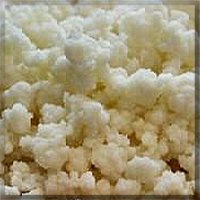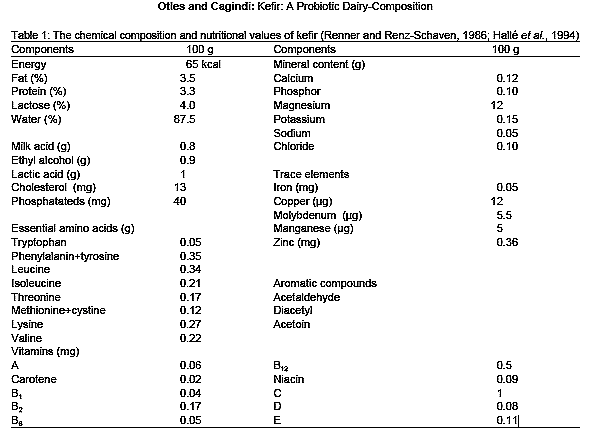

Kefir is essential for those who are fighting candida infections and interested in improving their overall health. Kefir is a fermented milk drink produced by the actions of bacteria and yeasts contained in kefir grains. Kefir grains are not grains in the same sense that wheat, oat and corn are grains, they are living organism that digest milk to produce kefir. This happens on the same principle as yogurt, but the grains are actually a separate living thing from the finished product, unlike yogurt. The grains look rather like cottage cheese and are similar to a gummy worm in texture. During fermentation, peptides and exopolysaccharides are formed that have been shown to have bioactive properties. Moreover, in vitro and animal trials have shown kefir and its constituents to have anticarcinogenic, antimutagenic, antiviral and antifungal properties. Although kefir has been produced and consumed in Eastern Europe for a long period of time, few clinical trials are found in the scientific literature to support the health claims attributed to kefir. The large number of microorganisms in kefir, the variety of possible bioactive compounds that could be formed during fermentation, and the long list of reputed benefits of eating kefir make this fermented dairy product a complex probiotic.
More than a thousand years of consumption have demonstrated that the microorganisms in kefir are not pathogenic. Milk inoculated with grains can suppress the growth of pathogens such as Salmonella or Shigella. The grain matrix is composed of a complex of 13% protein (by dry weight), 24% polysaccharide, plus cellular debris and unknown components. The principal polysaccharide is a water-soluble substance known as kefiran. Several homofermentative Lactobacillus species including L. kefiranofaciens and L. kefir produce this polysaccharide. Kefir contains a variety of aromatic substances including diacetyl and acetaldehyde. Diacetyl is produced by Str. lactis subsp. diacetylactis and Leuconostoc sp., which give it a characteristic flavour. The pH of kefir is 4.2 to 4.6. Microorganisms present in the grains are called probiotic because they are beneficial to human health. There are lactobacilli, such as Lb. brevis, Lb. cellobiosus, Lb. acidophilus, Lb. casei, Lb. helveticus, Lb. delbrueckii, Lb. lactis, etc., lactococci, such as different subspecies of Lc. lactis, Streptococcus salivarius ssp. thermophilus, Leuconostoc mesenteroides and L. cremoris and a variety of yeasts (fungi), such as Kluyveromyces, Candida, Torulopsis, and Saccharomyces.
Kefir Grain cultivation in milk whey produces a rather high (10[7]/ml) lactobacteria count. The Kefir Grain biomass growth in natural whey or its blend with condensed whey is a short process (up to 3-4 days). It can be extended through recurring renewal of the nutrient medium. The largest Kefir Grain biomass increase (23.13%) was achieved in natural curd whey after 3 days of cultivation. The composition of the Kefir Grain protein acid hydrolysate by indispensable amino acids (IAA) is as follows (mg/100g): valine 220, isoleucine 262, leucine 444, methionine 137, lysine 376, threonine 183, phenylalanine 231, tryptophan 70; the total IAA is 1923 mg/100 g. The Kefir Grain dry matter (DM) contained 33.0% raw proteins, 9% raw ashes, 1.8% raw cellular tissues, 0.2% raw fats, the following macro elements (%): K (1.65); Ca (0.86); P (1.45); Mg (0.30), and the following microelements (mg/Kefir Grain): Cu (7.32); Zn (92.7); Fe (20.3); Mn (13.0); Co (0.16); Mo (0.33). Moreover, B-group vitamins were found in the Kefir Grain mass: B5 ~3mg/Kefir Grain; B2 < 5 mg/Kefir Grain; B1 < 10 mg/Kefir Grain.

Definition of terms:
Traditional societies have successfully used real Kefir for thousands of years to culture milk products in a primitive environment that lacked the technology of modern societies. (In a goats stomach hung in a doorway, for example).
Cultivating Kefer Grains (Starter) - Kefir grains are prepared in a goat-hide bag filled with pasteurized milk inoculated with sheep intestinal flora, followed by culture of the surface layer in milk. A polysaccharide layer gradually appears on the surface of the hide. The layer is removed from the hides and propagated in pasteurized milk. Kefir grains appear as pieces of coral or small clumps of cauliflower florets or pop corn and range from 3 to 20 mm in diameter (Libudzisz and Piatkiewicz, 1990). The grains look like composition of kefir is variable and not well defined gelatinous white or yellow particles. These grains (Zubillaga et al., 2001) contain lactic acid bacteria (lactobacilli, lactococci, leoconostocs), acetic acid bacteria and yeast mixture clumped together with casein (milk proteins) and complex sugars by a matrix of polysaccharides.
Medicinal Uses - Kefir is used in hospitals and sanatoria for a variety of conditions, including metabolic disorders, Atherosclerosis, and allergic disease. It has even been used for the treatment of tuberculosis, cancer, and gastrointestinal disorders when no modern medical treatment was available. Its consumption has also been associated with longevity in Caucasus. Kefir possesses antimicrobial activity in vitro against a wide variety of gram-positive and gram-negative bacteria, and against some fungi. In Zacconi et al.ís recent study, the antagonistic effects of kefir against Salmonella kedougou were attributed to the complexity and vitality of the kefir microflora. Ingestion of the lactic acid bacteria bifidobacteria improves the colonic microflora by increasing bifidobacteria levels. Lactobacillus casei reduces the duration of some types of diarrhea. Probiotic effects of lactic acid bacteria and FM can be categorized in the following way:The intestinal microflora are important for maturation of the immune system, the development of normal intestinal morphology and in order to maintain a chronic and immunologically balanced inflammatory response. The microflora reinforce the barrier function of the intestinal mucosa, helping in the prevention of the attachment of pathogenic microorganisms and the entry of allergens. Some members of the microflora may contribute to the body's requirements for certain vitamins, including biotin, pantothenic acid and vitamin B12. Alteration of the microbial flora of the intestine, such as may occur with antibiotic use, disease and aging, can negatively affect its beneficial role. The main health benefit of yogurt and related fermented milk products is to improved lactose digestion; while bifidobacteria primarily affects the balance of the colonic microflora; and kefir and L. casei provide more global benefits, the first in relation to its antimicrobial effects and the second to diarrhea.
Contra-indications - hypersensitivity to milk products and probiotics. The most common adverse reactions with probiotic foods are gastrointestinal and include flatulence and constipation.
Ingredients:
Method: